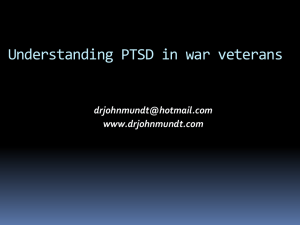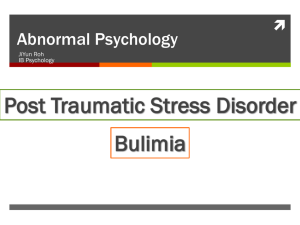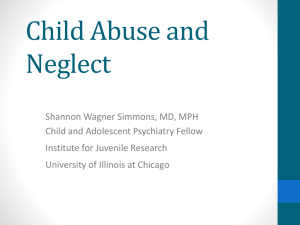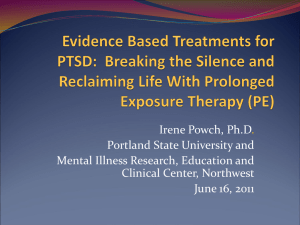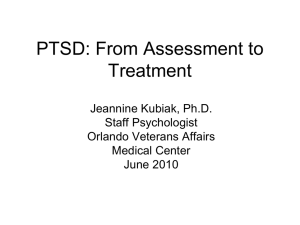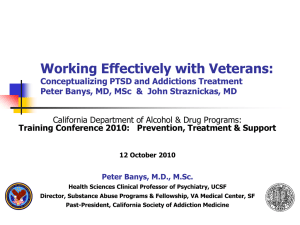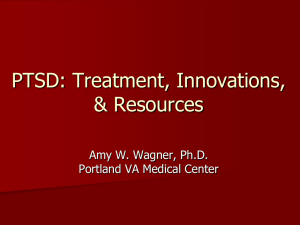Psychological Theory of PTSD and Evidenced
advertisement
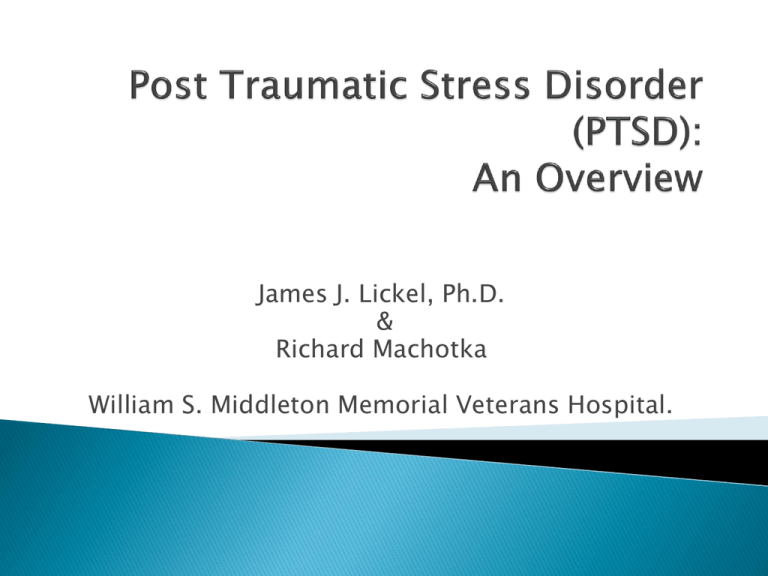
James J. Lickel, Ph.D. & Richard Machotka William S. Middleton Memorial Veterans Hospital. Cluster of symptoms that follow exposure to a potentially traumatic event Marked by clear cognitive, behavioral, and physiologic changes Can be chronic if untreated and greatly affect quality of life NOT a sign of weakness, lack of resiliency, or lack of preparation At least 50% of population will experience “trauma” in their lifetime, most more than once Most will experience symptoms of PTSD initially, but won’t go on to develop PTSD There are gender, racial, and ethnic differences in exposure to trauma and development of PTSD Seeing Dead Bodies/Remains Shot At/Receiving Small Arms Fire Being Attacked/Ambushed Receiving Artillery, Rocket, Mortar Fire Knowing Someone Killed/Ser. Injured Clearing/Searching Homes Shooting/Directing Fire at Enemy Ill/Injured Women/Child Couldn't Help Seeing Dead/Serious Inj. Americans Handling/Uncovering Human Remains Resp. for Death of Enemy Combatant Participating in Demining Ops Buddy Shot/Hit Near You Engaged in Hand-to-Hand Combat Saved Soldier/Civilian Life Being Wounded or Injured Responsible for Noncombatant Death Close Call/Hit but Saved by Gear 95% 93% 89% 86% 86% 80% 77% 69% 65% 50% 48% 38% 22% 22% 21% 14% 14% 8% 0% Hoge, et al, 2004, NEJM 10% 20% 30% 40% 50% 60% 70% 80% 90% 100% Event and PTSD Risk 60 50 40 30 20 10 0 Torture Rape Breslau et al., 1999 Beating Other SA Accident Sudden Death Child's Illness Witness Natural Disaster 5 Re-experiencing: • Intrusive thoughts or memories about the trauma • Nightmares • Flashback • Distress when reminded of the event (5 senses) • Physiological reactions Avoidance • Avoidance of trauma-related thoughts, feelings, or conversations • Avoidance of trauma-related places, people, or activities Arousal Symptoms • Impaired sleep • Irritability or outbursts of anger • Difficulty concentrating/focusing • Hypervigilance • Feeling jumpy or easily startled Negative alterations in thoughts and mood • Difficulty remembering aspects of event • Exaggerated beliefs or expectations about self, others, or the world (“No one can be trusted”) • Loss of interest in past enjoyable experiences • Feeling detached or cut-off from others • Emotional numbness Associated Problems Substance Abuse Depression PTSD Physical Health Problems Anxiety Panic Relationship Problems Psychological Theory of the Development and Maintenance of PTSD Symptoms Common Reactions to Trauma • Re-experiencing • Intrusive thoughts • Strong emotions when triggered by reminder Adaptive Function Easily accessed memories that warn of danger • Avoidance • Of stimuli present at time of trauma • Hyperarousal • Increased vigilance • Anger Reduces likelihood of repeated exposure to threat Increased attention to threat & Display of preparedness Psychological Processes Involved in Development of Symptoms of PTSD Associative Learning Ethnic dress Dust in the air Group of kids Military gear Density of housing Child’s laughter Smell of trash Knee pain Sound of gravel Debris Psychological Processes Involved in Development of Symptoms of PTSD Cognitive Change “IEDs can be planted anywhere.” “He died on my watch.” “I must have done something to ask for this.” “Markets and crowds are unsafe.” “I trusted this man, it is my fault.” “You can never let your guard down.” “Natural Recovery” vs. PTSD Avoidance Negative Beliefs PTSD Symptoms (Dunmore, Clark, & Ehlers, 2001) Demographics Social Support Etc. Time Psychological Processes Involved in Maintenance of Symptoms of PTSD Avoidance Ethnic dress Dust in the air Group of kids Military gear Density of housing Child’s laughter Smell of trash Knee pain Sound of gravel Debris Psychological Processes Involved in Maintenance of Symptoms of PTSD Generalization of Beliefs “I missed the IED.” “I asked for this.” “I am incompetent.” “I am a trash.” Current research suggests a number of physiological differences found in people diagnosed with PTSD ◦ Hormonal differences: Abnormalities in stress response hormone levels (glutamate, GABA, Norepinephirne, CRF. Responsible for preparing our bodies to respond to threat > constant state of readiness ◦ Brain differences: Smaller hippocampus (Inhibition of HPA axis and processing of memories) Over-reactive amygdala (decreased threshold for “firing”) Under-reactive prefrontal cortex (inhibits amygdala and interferes with working memory) Clinical Practice Guidelines Psychotherapy va/dod cpg Pharmacotherapy ISTSS cpg Significant Benefit • Cognitive Processing Therapy (VA has trained 1,200 LIPs) • Prolonged Exposure Therapy (VA has trained 1,500 LIPs) • Stress Inoculation Training • Eye Movement Desensitization and Reprocessing (EMDR) First-line pharmacologic Tx: Some Benefit • Imagery Rehearsal Therapy (IRT) • Brief Psychodynamic Therapy • Note about relative efficacy and increased risk of return of symptoms following stop of medication. • SSRIs: (Sertraline / Paroxetine / Fluoxetinte) • SNRI: (Venlafaxine) • Other 2nd Generation Antidepressants: (Mirtazapine) • Antiadrenergic: (Prazosin; Propranolol. Psychoeducation Stress/arousal reduction techniques Review of traumatic memories Exposure to avoided situations Modification of trauma-related beliefs 9-15 sessions; averages 10 sessions 90 min sessions 1: Assessment, treatment overview, PTSD psychoeducation, breathing retraining 2: In Vivo Exposure (continue throughout) 3-5: Imaginal Exposure 6-9: “Hot Spot” exposure 10: Final Imaginal exposure, wrap-up Exposure Hierarchy 1. 2. 3. 4. 5. 6. 7. 8. 9. 10. 11. 12. 13. 14. 15. 16. 17. 18. 19. 20. Grocery store with partner, not busy Restaurant with partner, back to wall Grocery store alone, not busy Grocery store with partner, moderately busy In line, facing sideways, wall to back Restaurant, whole family, back to wall Restaurant with partner, back to tables Elevator,1 or 2 people Movie with friends In line, facing forward or no wall at back Grocery store with partner, crowded Grocery store alone, moderately busy Feeling hot/sweaty Elevator, many people Mall alone, moderately busy Gym Restaurant, whole family, back to tables Go to friend’s house Mall alone, crowded Grocery store alone, crowded 30 35 45 50 50 50 60 60 60 65 65 65 70 75 75 80 80 80 95 100 Anxiety Anxiety increases Avoidance This situation is dangerous; I got out just in time; Something awful could have happened Time Courtesy of Sally Moore, Ph.D. Anxiety Time Stop avoidance Anxiety decreases on its own This situation was not as dangerous as it felt; I can tolerate anxiety; I don’t have to avoid to feel better. Courtesy of Sally Moore, Ph.D. Psychoeducation Trauma account (evidence of efficacy without) Identification of “Stuck Points” Cognitive restructuring Psychoeducation Impact Statement “Stuck Points” ◦ Those things trauma survivors say to themselves about the trauma/self/others/world. ◦ Examples “It was my fault. I could have prevented it.” “I am a monster for what I did during the war.” “I should have been able to save everyone.” “The world is an incredibly dangerous place.” It is how we THINK about the event, not the event itself, that often causes us lasting distress ◦ Ex: Friend passing by A-B-C Model – core of CPT A = Event B= Belief/Thought C = Feeling Firefight resulting in casualty I let my friend die Guilty Sad Sessions 4 - 6: Write/Read Trauma Account Sessions 6 - 7: Cognitive Work in depth Sessions 8 – 12: Explore Themes of Safety, Trust, Power/Control, Esteem, and Intimacy Continue to read account throughout course of treatment for purposes of exposure Session 12: Review of 2nd Impact Statement In general, trauma-focused therapies more effective than non-specific/supportive interventions and no treatment. No consistent differences observed between traumafocused therapies, though there is limited research regarding this. Initial response rates of EBP for PTSD range between 4092%. Regular therapy attendance and family support associated with more positive outcome Initial severity of symptoms and benzodiazepine use associated with poorer outcome. Outcomes for Veterans with PTSD PCL Prolonged Exposure Therapy Cognitive Processing Therapy 70 70 60 60 50 50 40 40 30 30 20 d = 0.80 d = 0.43 20 10 10 0 0 PE PCT (Schnurr et al., 2007) Pre Post d = 1.58 d = 0.50 CPT WL (Monson et al., 2006) OEF/OIF Combat Veterans with PTSD PCL Prolonged Exposure Therapy Cognitive Processing Therapy 70 70 60 60 50 50 40 40 30 30 20 d = 2.07 20 10 10 0 0 Pre Post (Tuerk et al., 2011) Pre Post d = 1.46 Pre Post (Chard et al., 2010) PTSD Resources • http://www.ptsd.va.gov/ PTSD Resources • www.istss.org PTSD Treatment Resources • www.abct.org • Find a Therapist • http://locator.apa.org

